Art - 4. April 2022
"In from the Margins" for refugee artists at Edinburgh Printmakers.
Europe's refugee crisis and its impact on artists
An interview with Mónica Laiseca, Project Manager for "In from the Margins" at Edinburgh Printmakers.
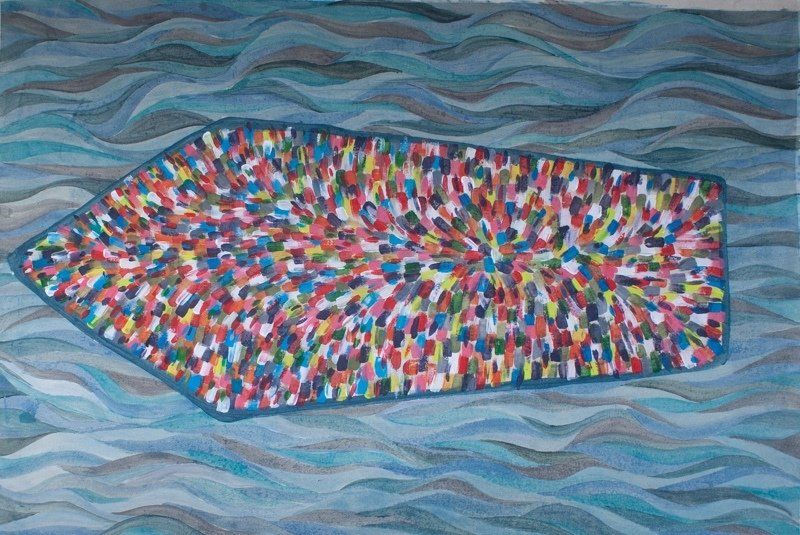
Arafa and The Dirars - A boat in the Mediterranean 2021 - acrylic and watercolours on calico
According to the UNO Flüchtlingshilfe over 4 million people have fled Ukraine and are seeking protection in neighboring countries. 6.5 million are fleeing within Ukraine. At the same time, other crises must not be forgotten: according to the UNO, 26.6 million people are on the run worldwide, more than ever before. Not to forget the Syrian war, which has been raging for 11 years and which, with 5.7 million registered refugees, is one of the largest refugee crises worldwide.
Refugees need to be re-anchored in life. In addition to the provision of livelihoods, there are many approaches and now a Europe-wide refugee project has been formed that gives refugee artists the opportunity of funded residencies so that they can continue to practice their art and also lets them learn the technique of printmaking.
The project was inspired by the arrival in England of artist and Iranian Paralympic medalist Mohammad Barrangi, who was welcomed to the Art House in Wakefield for what became Studios of Sanctuary Residency in 2017. Barrangi then became the first artist in residence as part of the project at Edinburgh Printmakers ahead of his exhibition Anything is Possible. Alethea & Art reported on this.
Alethea & Art Magazine interviewed Mónica Laiseca, project manager for "In from the Margins," a pan-European refugee project that brings together five printmaking studios to create a "Studio of Sanctuary" network: Edinburgh Printmakers, Scotland; Cork Printmakers, Ireland; AGA LAB, Amsterdam, Netherlands; Funen Printmaking Studio, Odense, Denmark; and International Center for Graphic Arts, Ljubljana, Slovenia.
The project will offer 30 funded residencies for artists who identify as refugees or who have experienced displacement. The artists have been through dramatic events. To what extent can art help them overcome them and continue to be creative, or use their work to draw attention to the conflicts in society.
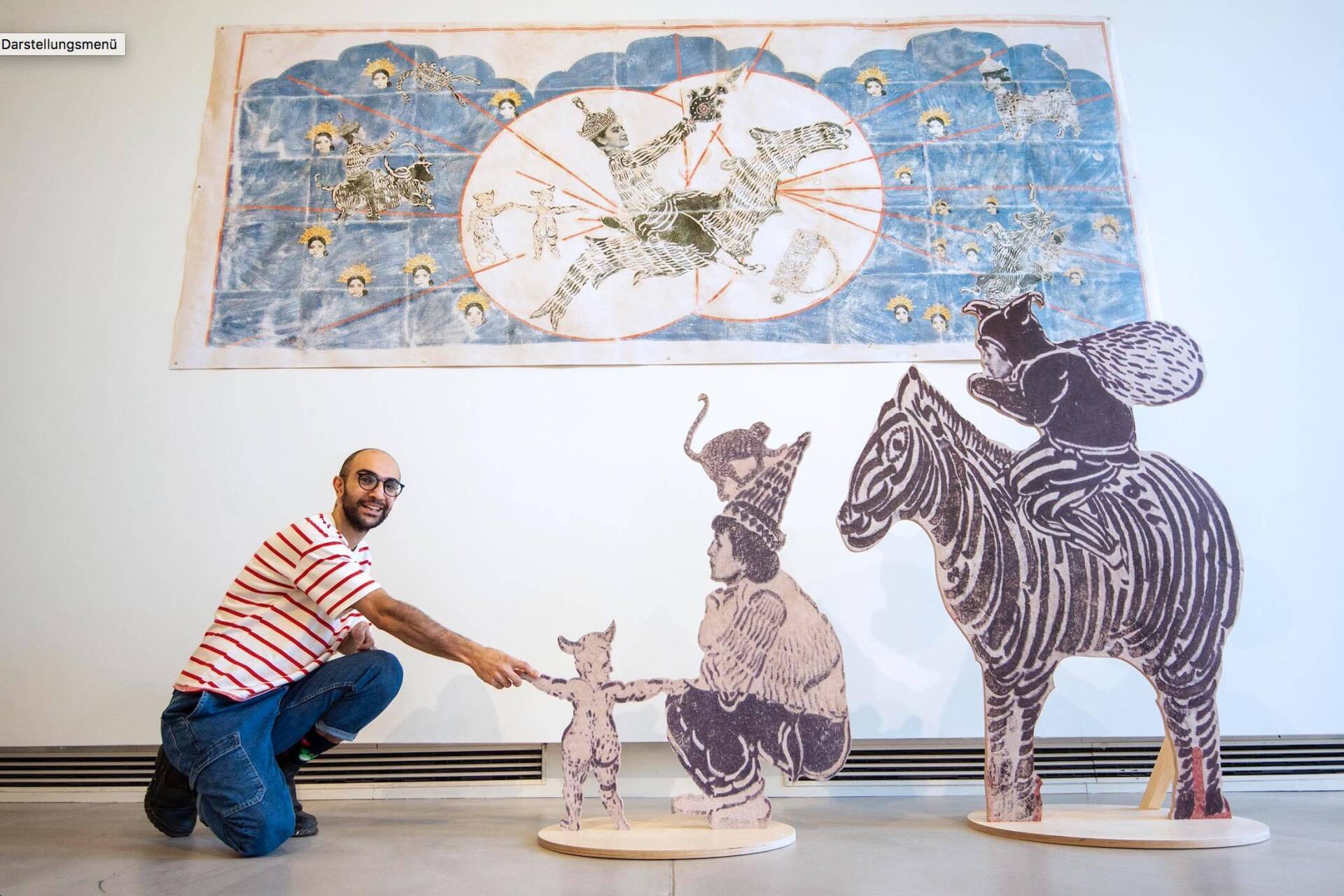
Mohammad Barrangi in January 2022 at his exhibition Anything Is Possible at Edinburgh Printmakers
©Mohammad Barrangi
Interview with Mónica Laiseca
Alethea & Art Magazine: Can you tell us about your background in the arts, and how you ended up working as a Project Manager for In from the Margins?
Mónica Laiseca: I have worked in visual arts organisations and arts education for over fifteen years and have always been interested in cultural mobility, so my present job is an excellent fit for me. I grew up in Spain in the years running up to its accession to the EU and its opening-up to neighbouring countries, which created a lot of new opportunities. Having the chance to live abroad and connect with people further afield, including most recently moving to Scotland to live and work, truly expanded my life possibilities, and I remain deeply passionate about it.
In from the Margins is a very special project, in that it brings together five printmaking studios based in cities in the periphery of Europe to set up a Studio of Sanctuary network: Edinburgh Printmakers, Scotland; Cork Printmakers, Ireland; AGA LAB, Amsterdam, Netherlands; Funen Printmaking Studio, Odense, Denmark; and International Center for Graphic Arts, Ljubljana, Slovenia. This Creative Europe funded project offers 30 supported residencies to artists who identify as refugees or with experience of displacement, culminating in a group exhibition and symposium at Edinburgh Printmakers in spring 2023.
I joined Edinburgh Printmakers as the Project Manager for In from the Margins and feel incredibly privileged to be part of it. In my role, I support our collaborators across the network as well as co-ordinate the residencies and engagement programme at Edinburgh Printmakers. The opportunity to both work closely with artists and colleagues on the ground in Edinburgh, and have discussions with our partners about how the residencies are running in different cities, is very energising, and means that different perspectives can shape the programme.
Alethea & Art Magazine: What criteria did you use to select the artists for this programme?
Mónica Laiseca: Understanding how transformative or significant the opportunity to be in residency could be for each individual artist, in terms of helping them further their practice, was key. In our selection, we prioritised artists for whom we felt this could make the biggest difference.
We were also interested in hearing about the work that the artists wanted to make while in residency, its possibilities and how printmaking could be a tool for them. The residencies are open to artists without previous experience of printmaking, as all resident artists will be given training on a process of their choice and technical support to make work. This is very much in keeping with how printmaking studios run; they are collective workspaces where artists exchange technical knowledge and support one another day-to-day.
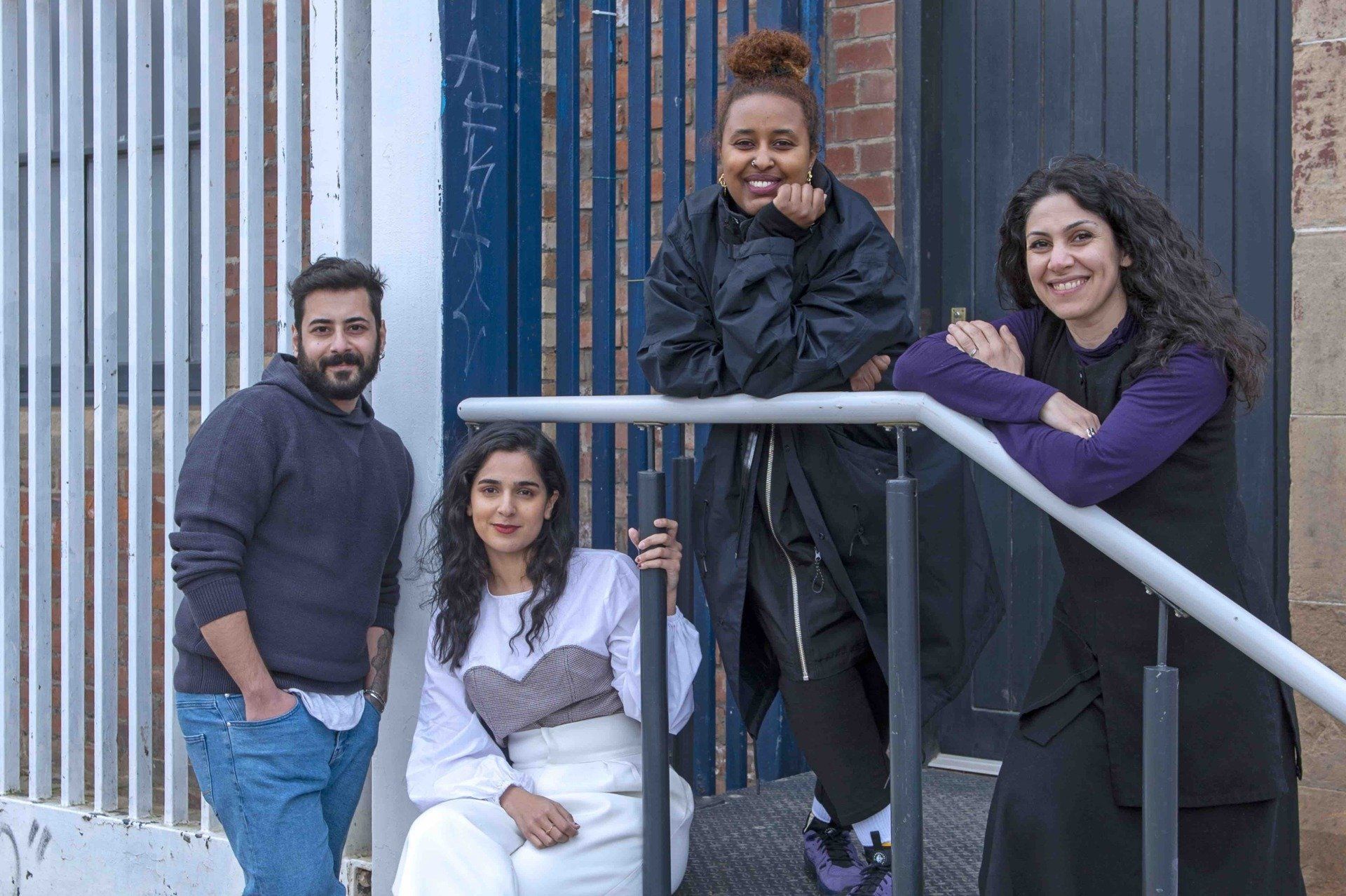
"In from the Margins" resident artists at Edinburgh Printmakers
L-R Mousa AlNana, Aqsa Arif, Najma Abukar, Paria Goodarzi
The Dirars and Zory Shahrokhi (not pictured) will also be in residency at EP
© Neil Hanna
At Edinburgh Printmakers, we were humbled by many of the personal stories that artists shared with us during their interviews, and the incredible sense of resilience and determination that they conveyed in looking at the future.
Alethea & Art Magazine: The artists have certainly been through dramatic events. To what extent can art help them overcome them and are they supported in other ways?
Mónica Laiseca: The primary focus of the In from the Margins residency programme is to celebrate and platform artists’ work and to support them to develop professionally. To literally bring their practices from the margins into the centre stage. In hosting these artists, it is important to remember that their lived experiences of displacement are all individual and may not necessarily manifest in their creative work. We need to be cautious to not force labels on the artists or to have pre-conceptions about the type of work that they want to make.
At Edinburgh Printmakers, we were humbled by many of the personal stories that artists shared with us during their interviews, and the incredible sense of resilience and determination that they conveyed in looking at the future. For some of our resident artists, art has been a tool for coping through the difficult transition of displacement. The Leeds-based Sudanese collective The Dirars, for example, spent four years in a refugee camp in Egypt and it is during this time that they started making work together and developed their skills in drawing, painting, and poetry. Iranian born artist Paria Goodarzi and Syrian artist Mousa AlNana, both living in Glasgow, are also passionate about making art available as a tool to bridge extra support for newly arrived migrants and change the narrative around refugee communities. Over the last year, they have been facilitating The Museum of Things, a creative space in Maryhill in the north of Glasgow where asylum seekers, refugees and migrants meet weekly to experiment with different artistic techniques, share their skills and celebrate self-expression.
While in residency, artists will be mentored and supported to make new work by their host studio, as well as encouraged to connect with studio members and engage with the local arts scene. Artists will also be invited to present their work at an open studio event and deliver an artist talk or workshop. Later in the year, all resident artists across the programme will be invited to come together online to share their work, and these discussions will provide a starting point from which to develop the final exhibition and symposium.
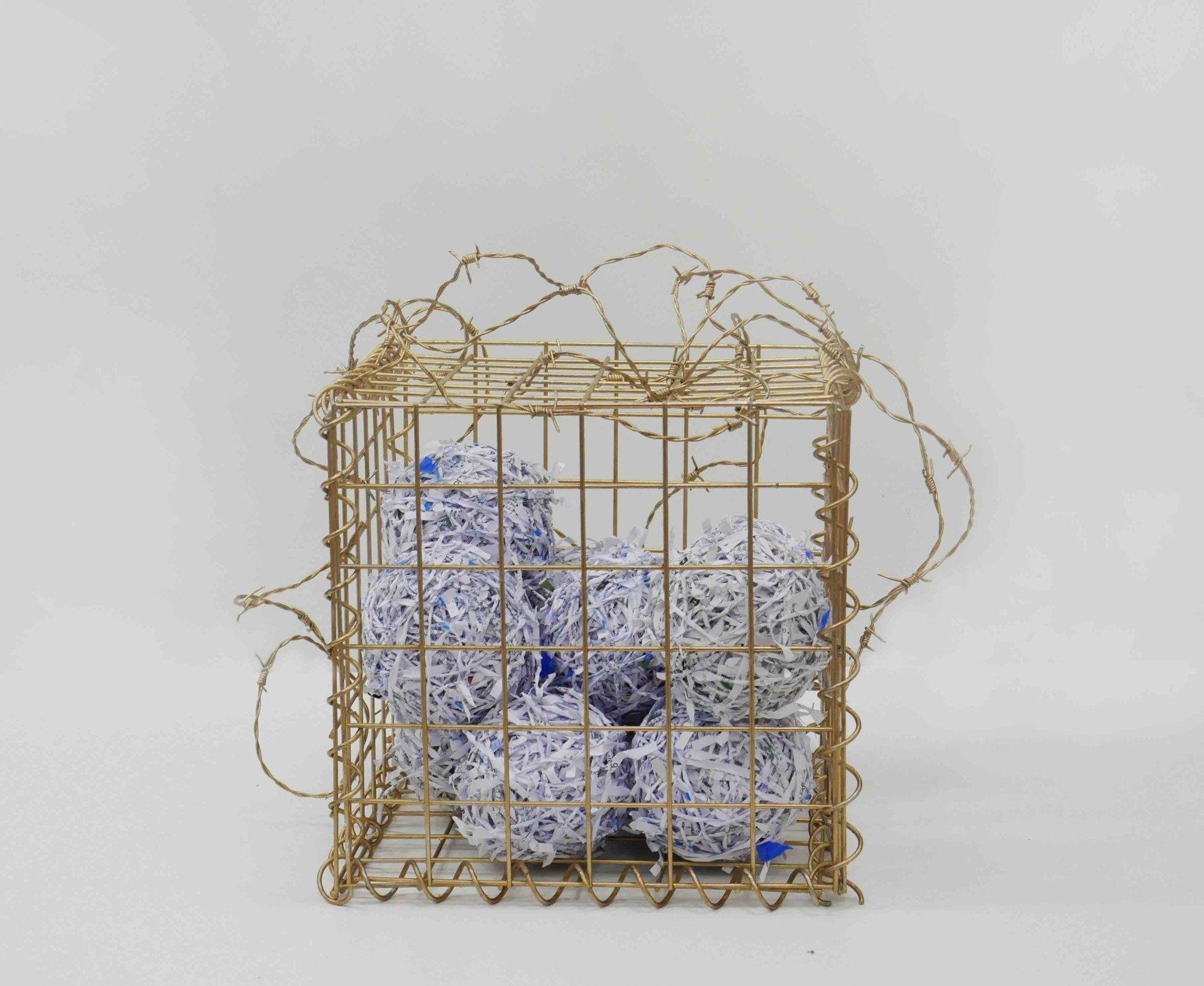
Artworks by Resident artists - Painting and Environmental art - Paria Moazemi Goodarzi,
The Redistribution of Memory. 2021. Metal, Paper fibber, barbed wire
Alethea & Art Magazine: Which crisis regions are the artists from and how long will they stay in Edinburgh?
Mónica Laiseca: The residency programme supports artists with lived experience of displacement, and this has a different meaning from country to country. In Slovenia, for example, migrant populations are very transient and tend to not stay in the country for long. Our partners in Cork, who are taking part in the programme at a time when the Irish asylum system of direct provision is expected to come to an end, are also seeking to include artists within traveller communities.
From the artists selected thus far, several are refugees from Syria and Iran, but there are also artists who have migrated from Iraq, Somalia, Sudan, Pakistan, Uruguay, Bosnia and Herzegovina, and Kosovo. The residencies are 1-month long, and we will continue to work with the artists through the final exhibition and symposium.

Mousa Al Nana, Unorthodox Heretics (Shame). 2020.
Collage and mixed media on glass

Aqsa Arif, Within her Window of Decadence, 2021.
Inkjet print. Courtesy of Aqsa Arif
Alethea & Art Magazine: What does the role of Project Manager of a cross-European residency programme mean to you in our time?
Mónica Laiseca: I am very interested in how art residency programmes can be actively shaped to respond to the needs of different communities and local contexts, and how more inclusive models for working in the arts may arise through this. This, coupled with the opportunity to be involved in one of the last Creative Europe funded arts projects in Scotland, is what initially drew me to this role.
Now that In from the Margins is up and running, I strongly feel that for everyone involved in the project it is crucial to really listen to the artists, to be able to support them in a way that is meaningful to them and become aware of some of the barriers that they are facing. For example, one of our resident artists in Edinburgh told me that he has never exhibited with Scottish artists before. How can we help shift this narrative?
The role of Project Manager can provide focus to ensure that this learning is not lost and can be applied and made visible. At the same time, the project connects Edinburgh Printmakers with four European printmaking studios, at a time when borders are being redefined around us and a common response to the refugee crisis in Europe is yet to be found.
Art is not easily contained within borders and this programme has the scope to facilitate a dialogue about cross-border solidarity and internationalism that is grounded on the lived experiences of the resident artists taking part. I am keen to work with our CEO Janet Archer and our partners across Europe and partners to devise an exit strategy, so that Studios of Sanctuary network can continue to run longer term and we can remain closely linked.
Alethea & Art Magazine: Thank you very much for the interview.

Mónica Laiseca
Mónica Laiseca is Project Manager for In from the Margins at Edinburgh Printmakers. Previously, Mónica worked as a curator and in arts education, holding positions at Glasgow School of Art, University of East Anglia, Instituto Cervantes (Tokyo), Belfast Exposed and Open Eye Gallery (Liverpool), with recent projects focusing on participatory arts, performance and embedded approaches to running art-residencies.
------
Edinburgh Printmakers:
W: https://edinburghprintmakers.co.uk/projects/in-from-the-margins/
I: @infromthemargins
The artists selected by Edinburgh Printmakers are:
Aqsa Arif is a Scottish-Pakistani interdisciplinary artist based in Glasgow. Her work incorporates the interdisciplinary mediums of poetry, printmaking, installation and film to construct complex structures in which she explores the surreal nature of the human psyche. As a Pakistani refugee to Scotland, she has described her experience as a life with the split of two cultural identities. This polarity underpins her work and is manifested through her use of film. Printmaking also plays a significant role in her practice. By re-moulding its two-dimensional plane within her three-dimensional surreal world, she personifies the medium within her structures. Since graduating from the Glasgow School of Art in 2019, Aqsa has exhibited her work in Gallery of Modern Art, Jupiter Artland, Royal Scottish Academy and Tate Modern. She is also the co-founder of Salt Space Co-operative in Glasgow.
Arafa and the Dirars are an artists’ collective based in Hull. Born in West Sudan the Dirars family was resettled as refugees to the UK in 2015 through the UN Gateway Protection Programme. Having fled the war in Libya and during four years in a refugee camp in Egypt, they used the time waiting for a decision on their future to develop their skills in drawing, painting, and poetry. Today they use their art to reflect on their journey, share their story with others, and draw attention to the ongoing plight of millions of people fleeing war and persecution.
Mousa AlNana is a Glasgow based Syrian artist working in painting, print and graphic design. A Fine Art graduate from Damascus University and Master’s Graduate from Glasgow School of Art, Mousa’s work draws from his own experiences showing humanity in its different colours and its vulnerable stages, under rough surfaces and delicate lines. Using collage techniques and monochromatic style Mousa aims to share what lies between the human soul. He also works as part of Salt Space Co-operative delivering workshops for refugee artists in Glasgow.
Najma Abukar is a Somali born, Glasgow based photographer documenting cultural and gender identities, the African diaspora, and immigrant experiences. She is passionate about curating, archiving, and re-focusing the untold narratives of those underrepresented and
marginalized. Being a first-generation migrant woman of African heritage, her photographic
body of work focuses on the strife and resilience of the Other. Najma’s practice is concerned with issues of identity, belonging and (self) representation within the Scottish landscape.
Paria Goodarzi is an Iranian born artist, her practice revolves around cultural and political transfers and translocations, the ideas of the contemporary human condition, cultural identity and political issues that result in an ambivalent coexistence of civilised life, conflict, and displacement. Her work examines the hybrid condition of our society and the processes of formation, performance, and representation of identity through a multidisciplinary practice that often takes the shape of participatory and socially engaged artworks. Paria is a UNESCO RILA Affiliated Artist and co-founder of the art initiative ‘Distanced Assemblage’ with the aim of making a positive impact in the wellbeing and visibility of people from diverse cultural and social backgrounds by providing opportunities to engage with creative practice.
Zory Shahrokhi is a British-Iranian visual artist based in Greater London. She was born in Tehran and grew up in brutal poverty within a country that harbours a massive class divide and gender inequality. Her initial art training was with renowned teacher Ebrahim Jafari, who was a poet, artist and lecturer. Zory’s early work reflects her personal experiences and emotions through the abstract expression of the belaboured female body. Her practice developed through a concern for exploring cultural and political agendas, employing performance in relation to installation, photography and drawing. Through experimental work and symbolic expression, she investigates issues and perception around freedom related to displacement, exploitation, and gender oppression.
Facts and figures:
Source: UNO Flüchtlingshilfe
4. April 2022 - the interview was held by C. Mauer
ALETHEA & ART recommends:
April 4, 2022
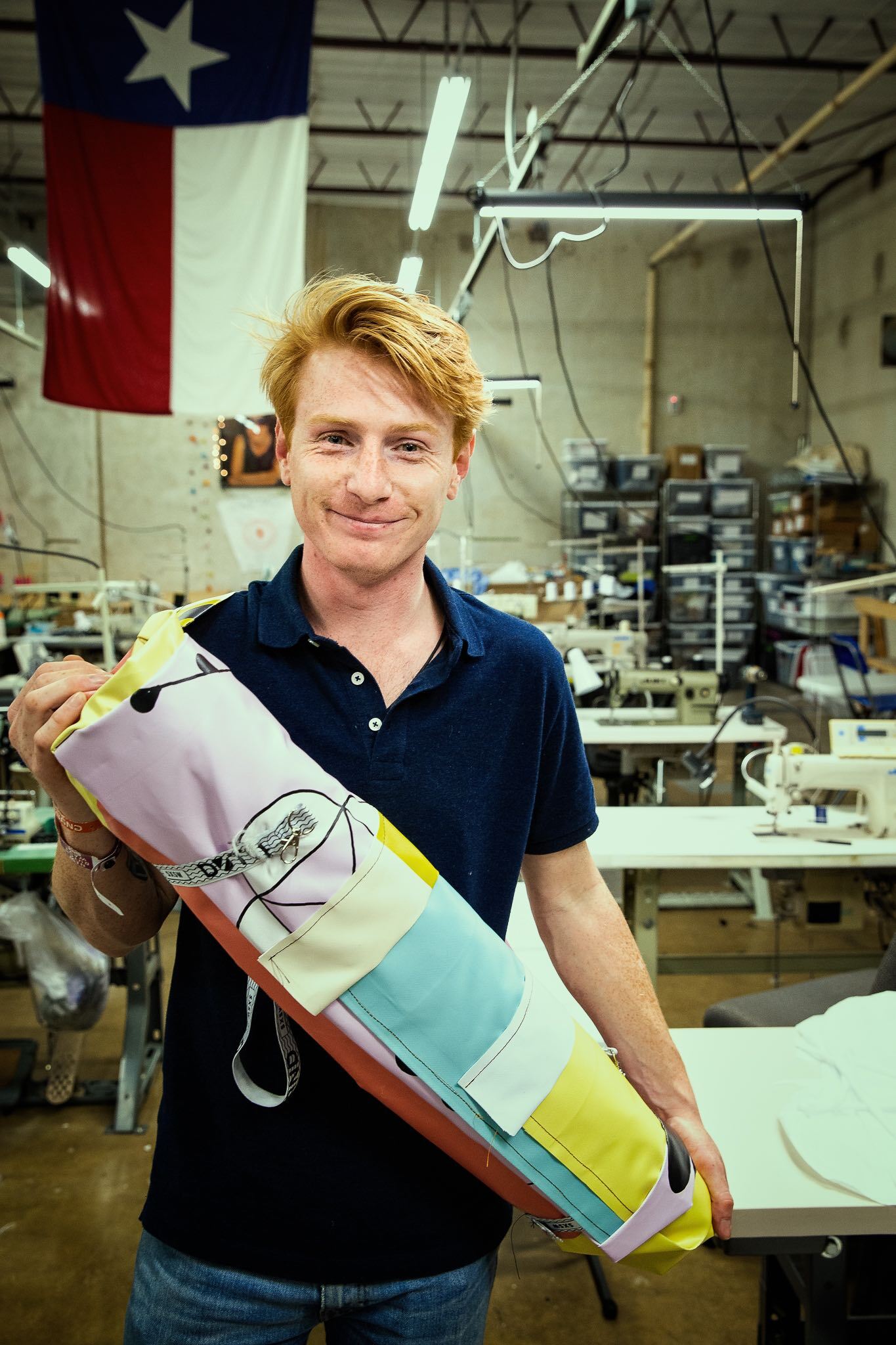
Fashion / Business - 1 April 2022
Sheltersuit - charity, real fashion circularity, life stories and a also new fashion initiative
Sheltersuit Foundation is a non-profit organization founded in 2014 by Bas Timmer to develop products that can alleviate the symptoms of homeless people. The Sheltersuit and the Shelterbag were created.
Sheltersuit Founder Bas Timmer
©Tony Docekal
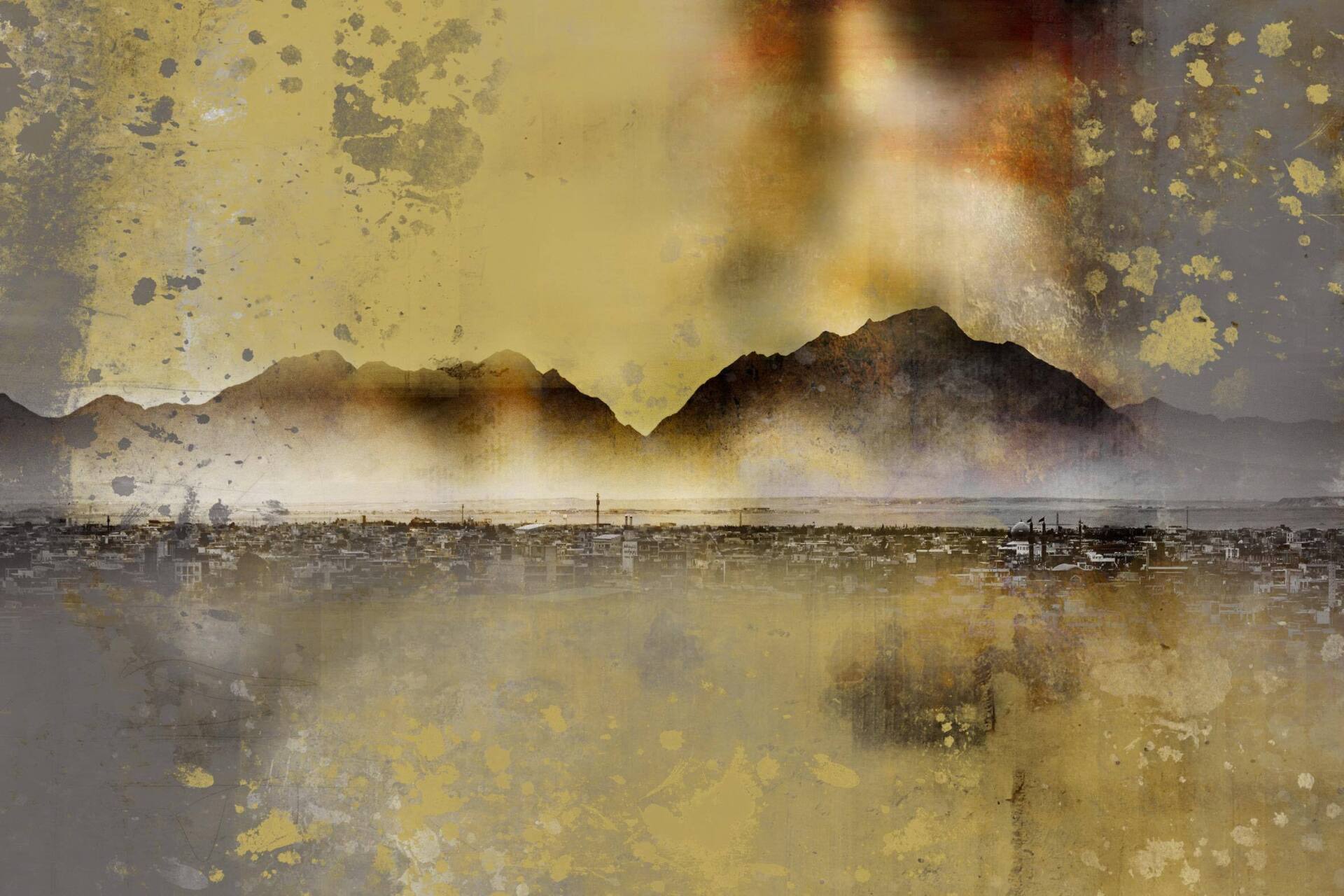
Art Calendar / Art, 12 March 2022
Dieter Nuhr - "Reisezeit - Zeitreisen" - Traveler and Artist -
"Art is always just a suggestion".
March 15-July 31, Hetjens Museum, Düsseldorf. "Reisezeit - Zeitreisen", a mixture of photography and painting, consists of romantic dream landscapes and paintings of ceramics, multilayered, poetic, and intricate, shown together with ceramics of the museum - The artist talks about his shared journey with the history of ceramics.
©Dieter Nuhr

Art Calendar, 31 March 2022
Tentative Words Change Everything
sculptures by Turner Prize-shortlisted Nathan Coley light up Sussex. The artist exclusively answers some questions about the project to Alethea & Art Magazine.
"You imagine what you wish for"
a slogan chosen by Nathan Coley for our time.
April 2 to August 29, 2022 - held in the County of Sussex
Tentative Words Change Everything ©Keith Hunter


